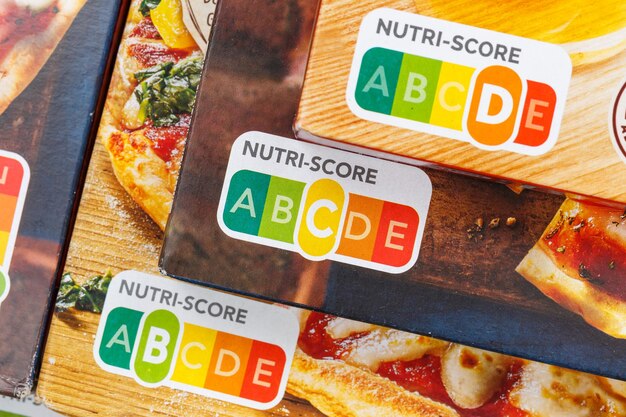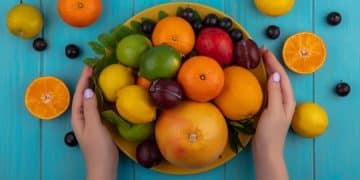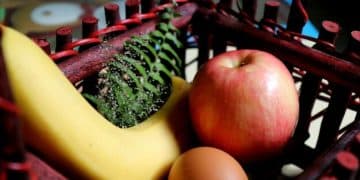Food Labels 2025: What’s New & How to Understand Them

The updated 2025 guide to understanding food labels introduces critical changes focusing on enhanced clarity regarding allergens, added sugars, and serving sizes, enabling consumers to make more informed and healthier dietary choices.
Navigating the grocery aisles can often feel like deciphering a complex code, especially when trying to make healthy choices. With each passing year, dietary recommendations evolve, and so do the regulations governing the information presented on our food. For 2025, a significant update to understanding food labels is on the horizon, promising greater transparency and empowering consumers like never before. Welcome to The Updated 2025 Guide to Understanding Food Labels: What’s Changed? – your essential resource for staying informed and making smarter decisions about what you eat.
Understanding the Core Philosophy Behind 2025 Label Updates
The changes to food labels in 2025 are not merely cosmetic; they represent a fundamental shift in how regulators aim to educate and protect consumers. At its heart, the updated philosophy emphasizes clarity, immediacy, and actionable information. Gone are the days when crucial details were buried in fine print or ambiguous terminology. The new guidelines reflect a commitment to making healthy eating choices more intuitive for everyone, regardless of their nutritional literacy.
This evolution is driven by several factors, including rising rates of diet-related diseases, a growing awareness of food allergies, and consumer demand for greater transparency from food manufacturers. The goal is to bridge the gap between scientific understanding and everyday purchasing habits, empowering individuals to take control of their health through informed food choices.
Manufacturers are now tasked with presenting information in a manner that is easily digestible at a glance, moving beyond compliance to genuine consumer empowerment. This goes beyond just presenting data; it’s about making that data truly useful in real-world scenarios, transforming the often daunting task of label reading into a straightforward process.
Enhanced Clarity on “Added Sugars”
One of the most significant changes addresses the pervasive issue of sugar consumption. While previous labels listed “Total Sugars,” the 2025 updates place a far greater emphasis on “Added Sugars.” This distinction is crucial, as naturally occurring sugars in fruits and milk have different nutritional implications compared to sugars added during processing.
Consumers will now find a clearer, more prominent declaration of added sugars, often expressed in grams and as a percentage of the Daily Value (DV). This helps to quickly identify products that are significant sources of added sugars, which are often linked to various health concerns when consumed in excess. The aim is to make it abundantly clear how much sugar has been intentionally introduced into a food item, allowing for more conscious dietary decisions.
- Easier identification of processed foods with high sugar content.
- Better differentiation between natural and added sugars.
- Informed choices for managing sugar intake.
This initiative directly addresses public health concerns about excessive sugar consumption, attempting to steer consumers toward healthier alternatives. The visibility of added sugars is designed to be a powerful nudge for both consumers and manufacturers to reconsider their product formulations, fostering a healthier food environment.
Allergen Information: A Spotlight on Safety and Specificity
For individuals with food allergies, label clarity is not just about health; it’s about safety, often life-saving safety. The 2025 updates introduce more stringent and comprehensive requirements for allergen labeling, aiming to mitigate risks and provide complete peace of mind. While the “Big 8” allergens (milk, eggs, peanuts, tree nuts, soy, wheat, fish, shellfish) were previously required, the new guidelines expand upon this, particularly concerning cross-contamination and clearer language.
Manufacturers are now obligated to use plain language that is easily understood, avoiding technical jargon or vague terms. This means clearer declarations like “Contains: Wheat, Milk” rather than relying solely on the ingredient list. The emphasis is on proactive disclosure, ensuring that critical allergen information is impossible to miss.

Updated Guidelines for Allergen Declaration
Beyond the mandatory “Contains” statement, the 2025 updates often encourage or mandate more explicit advisories regarding potential cross-contamination. While “May Contain” statements have been common, the new guidelines push for greater specificity where possible, encouraging manufacturers to improve their segregation processes or provide more precise risk assessments.
This also includes a focus on sesame, which has recently been recognized as a major allergen requiring explicit declaration in many regions. The new rules encompass a broader range of potentially problematic ingredients, reflecting evolving scientific understanding and consumer advocacy. The goal is to create a more inclusive and safer food supply for everyone, minimizing accidental allergen exposure.
- Mandatory disclosure for a wider range of allergens, including sesame.
- Clearer, easier-to-read “Contains” statements.
- Improved guidance on cross-contamination warnings.
The enhanced allergen labeling is a significant step forward in public health, providing a crucial tool for individuals and families managing food allergies. It shifts the burden from constant vigilance by the consumer to a greater responsibility on the part of the manufacturer to provide unambiguous information.
Serving Sizes: Redefining Reality and Portion Control
One of the most frequently misunderstood aspects of food labels has always been serving sizes. Often, the stated serving size bears little resemblance to what a person typically consumes in a single sitting, leading to skewed perceptions of calorie and nutrient intake. The 2025 updates are designed to bring serving sizes closer to realistic consumption patterns, making the nutritional information immediately more relevant.
This recalibration means that for many products, the serving size on the label will reflect the amount typically eaten, not necessarily a recommended portion. For example, a single-serving container that could reasonably be consumed entirely might now be labeled as one serving, even if its contents are numerically larger than a previous “serving.” This change aims to reduce confusion and make it easier for consumers to understand the true nutritional impact of what they’re eating.
Furthermore, the “Servings Per Container” information is often more prominently displayed, assisting in calculating total nutrient intake for packages that contain multiple servings. This helps individuals quickly assess how many servings they are actually consuming if they eat the entire package, thus avoiding accidental overconsumption.
Realistic Portions for Everyday Consumption
The revised serving sizes are based on updated consumption data, reflecting how people actually eat and drink. This move away from idealized or arbitrary serving sizes marks a more practical approach to food labeling. It acknowledges that consumers are more likely to scrutinize labels if the information feels genuinely applicable to their eating habits.
This reevaluation of serving sizes also impacts how daily values are calculated and presented, offering a more accurate snapshot of how a product contributes to one’s overall diet. The intention is to provide a more intuitive understanding of nutrient quantities, allowing for better tracking of caloric intake and specific nutrient targets, such as fat or sodium. The entire system is meant to be more user-friendly.
- Serving sizes reflect typical consumption patterns, not just arbitrary values.
- Easier calculation of total nutrients for multi-serving packages.
- Reduced chances of unintentional overeating due to misleading labels.
By aligning serving sizes with real-world eating behaviors, the 2025 labels empower consumers to make more accurate assessments of their dietary intake, promoting better portion control and healthier eating habits without the need for complex mental arithmetic.
Navigating the Evolving Daily Values (DVs) and Nutrient Percentages
The Daily Values (DVs) are the reference amounts of nutrients to consume or not to exceed each day, and they are foundational to understanding the percentage values listed on food labels. The 2025 updates reflect the latest scientific consensus on nutrient requirements, meaning that the DVs for certain nutrients have been adjusted. These adjustments can subtly, but significantly, change the “Percentage Daily Value” (%DV) presented on labels, influencing how consumers perceive a food’s contribution to their overall diet.
For instance, the DVs for nutrients like Vitamin D, potassium, and dietary fiber have seen revisions, aligning with more current dietary guidelines. This means a food item might show a different %DV for these nutrients compared to labels from previous years, even if its absolute nutrient content hasn’t changed. Consumers should be aware that these shifts reflect updated scientific understanding rather than a change in the food product itself.
The purpose of these updates is to provide more accurate and relevant guidance for achieving a balanced diet. By recalibrating DVs, the labels become a more reliable tool for identifying nutrient-dense foods and for managing intake of nutrients that consumers might need more or less of.
Impact on Specific Nutrients
Consumers will notice particular changes in the %DVs for certain vitamins and minerals. For example, Vitamin D values are now higher to reflect new recommendations for bone health, and potassium values might be adjusted to emphasize its role in blood pressure regulation. Dietary fiber DVs are also updated, highlighting the importance of fiber for digestive health and satiety.
Conversely, for nutrients like sodium, the DVs continue to emphasize moderation, guiding consumers away from excessive intake. The new percentages provide a clearer compass for navigating nutritional goals, making it easier to identify products that support specific health objectives, whether it’s increasing fiber intake or reducing sodium.
- DVs for essential vitamins and minerals align with current scientific recommendations.
- Updated %DV figures provide a more accurate picture of nutrient contribution.
- Helps consumers prioritize nutrient-dense foods based on evolving dietary needs.
These adjustments to DVs are a critical component of the 2025 food label overhaul, ensuring that the guidance provided is as current and scientifically sound as possible, empowering consumers to make choices that truly align with contemporary health advice.
Beyond the Box: Digital Integration and QR Codes
While physical labels remain indispensable, the 2025 updates also acknowledge the increasing role of technology in consumer information. Many manufacturers are integrating digital components into their labeling strategies, often through the use of QR codes. These codes, when scanned with a smartphone, can link consumers to a wealth of additional information that cannot physically fit on a product package.
This digital expansion offers unprecedented depth beyond the basic label. Consumers can access detailed nutritional breakdowns, elaborate allergen profiles, sourcing information, sustainability practices, ethical certifications, and even recipes. This provides curious consumers with the option to delve much deeper into a product’s background, fostering greater transparency and trust.
The move towards digital integration reflects a broader trend of consumer demand for more comprehensive and easily accessible information. It allows for dynamic updates, ensuring that consumers always have access to the latest product specifications, rather than being limited by static print on a package. This is particularly useful for products with complex formulations or those undergoing frequent updates.

Benefits of Scannable Information
The ability to scan a QR code immediately connects the consumer to a richer data environment. This can include information about the product’s journey from farm to fork, detailed explanations of less common ingredients, or even videos about the manufacturing process. For those with specific dietary needs or ethical concerns, this extended information can be invaluable in making purchase decisions.
This digital layer also serves as an educational tool, allowing consumers to learn more about nutrition, food science, and sustainable practices at their own pace. It transforms the act of grocery shopping into a more interactive and informative experience, moving beyond passive consumption to active engagement with food choices.
- Access to comprehensive nutritional and ingredient details beyond the physical label.
- Information on sourcing, sustainability, and ethical practices.
- Dynamic updates ensuring consumers have the latest product data.
The integration of digital tools like QR codes in 2025 food labels marks a pivotal step towards a more informed and transparent food ecosystem, empowering consumers with unparalleled access to product details whenever and wherever they need it.
Decoding New Terminology and Emerging Claims
As consumer awareness around health and diet grows, so does the lexicon of food marketing. The 2025 updates also implicitly or explicitly address new terminology and emerging claims that might appear on food labels. This includes clearer guidelines around terms like “plant-based,” “regenerative agriculture,” “upcycled ingredients,” and various other eco-conscious or health-focused descriptors.
Often, these terms lack universal definitions, leading to potential consumer confusion or even misleading claims. The updated regulatory landscape seeks to bring more consistency and truthfulness to such marketing language. This means manufacturers using these terms will likely face stricter requirements to substantiate their claims with verifiable data and clear definitions, reducing ambiguity.
The goal is to protect consumers from “greenwashing” or “healthwashing” – where products are marketed as healthier or more environmentally friendly than they truly are. This promotes a more honest dialogue between manufacturers and consumers, fostering credibility and trust in product branding.
Verifying “Green” and “Clean” Claims
Consumers are increasingly seeking products that align with their values, whether it’s sustainability, ethical sourcing, or minimal processing. The 2025 labeling guidelines aim to provide clearer pathways for understanding these claims. This might involve new certifications, standardized logos, or clearer textual explanations for terms like “carbon neutral” or “fair trade.”
The shift is towards greater accountability for environmental and ethical claims, ensuring that companies are not just using buzzwords but are genuinely adhering to specific practices. This empowers consumers to make choices that reflect not only their dietary needs but also their broader environmental and social consciences.
- Stricter definitions and substantiation requirements for new descriptive terms.
- Reduced ambiguity in marketing claims like “plant-based” or “regenerative.”
- Increased transparency in eco-friendly and ethical product declarations.
By providing clearer frameworks for new terminology and claims, the 2025 food labels help consumers cut through marketing noise, allowing them to confidently identify products that genuinely meet their health and ethical preferences.
Actionable Steps for the Empowered Consumer
With all these updates, the ultimate goal is to empower you, the consumer. Understanding these changes isn’t just academic; it’s about translating knowledge into action during your weekly grocery run. The 2025 food labels are designed to be your ally in making healthier, more informed choices, but only if you know how to wield them effectively.
Firstly, prioritize the “added sugars” section. This is a critical indicator of a product’s overall healthfulness. A quick glance can reveal whether a seemingly healthy item is actually loaded with sweeteners. Secondly, always double-check allergen statements, even for products you’ve bought before, as formulations can change. The new clarity in this area is specifically designed to make this process easier and safer.
Finally, embrace the revised serving sizes. They offer a more realistic reflection of what you’re likely to consume, helping you more accurately track your calorie and nutrient intake. Don’t be afraid to use the %DV as a quick guide for nutrients you want more or less of in your diet. These small, consistent actions can lead to significant improvements in your overall dietary habits and well-being.
Becoming a Savvy Label Reader
Beyond these immediate steps, consider exploring the digital side of food labels. Scanning QR codes can unlock a wealth of information, from detailed sourcing to comprehensive nutritional data, allowing you to dive deeper into products that pique your interest. This proactive approach helps you become a truly savvy consumer, not just a passive buyer.
Engage with the information. Question claims that seem too good to be true. Compare products side-by-side using the updated labels. The more you familiarize yourself with the new format and its enhanced features, the more confident and efficient you’ll become in making choices that align with your health goals and personal values. Your awareness is your most powerful tool in the evolving food landscape.
- Prioritize checking “added sugars” and updated allergen declarations.
- Utilize realistic serving sizes and %DVs for accurate nutrient tracking.
- Leverage digital tools (QR codes) for deeper product insights.
The 2025 food labels offer an unprecedented opportunity for consumers to engage more deeply with their food choices. By adopting these actionable steps, you can transform the way you shop and eat, leading to a healthier, more transparent, and more sustainable relationship with food.
| Key Update | Brief Description |
|---|---|
| 🍬 Added Sugars Clarity | Clearer declaration of sugars intentionally added during processing. |
| 🚨 Enhanced Allergens | More explicit and broader allergen warnings, including sesame. |
| ✅ Realistic Serving Sizes | Portions now reflect what people actually consume, not arbitrary values. |
| 📱 Digital Integration | Increased use of QR codes for accessing deeper product information. |
Frequently Asked Questions About 2025 Food Labels
The labels were updated to enhance clarity and accuracy, reflecting current scientific understanding of nutrition and addressing public health concerns like high sugar intake and food allergies. The goal is to empower consumers with more transparent and actionable information to make healthier dietary choices.
Total sugars include naturally occurring sugars (e.g., in fruit, milk) and added sugars. “Added sugars” specifically refers to sugars and syrups put into foods during processing. The 2025 labels highlight added sugars to help consumers distinguish them from natural sugars and manage their intake of added sweeteners more effectively.
Serving sizes on the 2025 labels are adjusted to be more realistic, reflecting typical consumption amounts. For some products, this might mean a larger serving size than before if current consumption patterns show people usually eat more than the previous arbitrary serving. This aims to provide a more accurate nutritional picture.
While the “Big 8” allergens remain mandatory, the 2025 updates place a particular emphasis on including sesame as a declared allergen, given its increasing prevalence in allergies. Labels also aim for clearer, more prominent language for all allergen warnings, enhancing consumer safety against cross-contamination.
Yes, many new labels feature QR codes that can be scanned with a smartphone. These codes often link to comprehensive digital information, including detailed nutritional breakdowns, sourcing details, sustainability practices, and other relevant product information that cannot fit on the physical package.
Conclusion
The updated 2025 food labels represent a significant stride towards greater transparency and consumer empowerment in the realm of healthy eating. By providing clearer information on crucial aspects like added sugars, allergen declarations, and realistic serving sizes, these labels are designed to make informed decisions more accessible to everyone. Coupled with the integration of digital tools for deeper insights, the evolving landscape of food labeling equips consumers with an unprecedented level of control over their dietary choices. Embrace these changes as an opportunity to become a more discerning, healthier eater, fostering a more mindful relationship with the food you consume.





